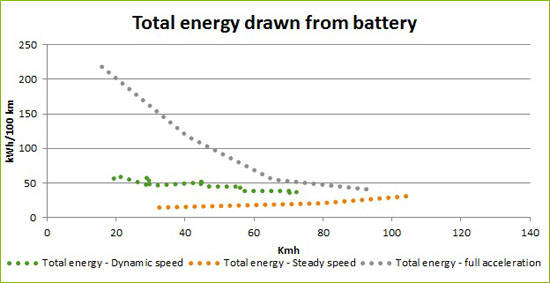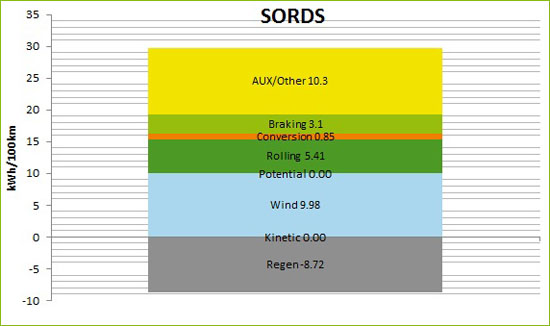Impact of tire pressure, load and wind
An EV uses energy just like any other car. The responsible driver will always try to keep the energy consumption to a minimum. The usual metric for EV mileage is kWh/100km. Some typical examples of EV mileage are shown below.
| Slow city driving |
NEDC homologation |
Mixed |
Aggressive |
Fast highway |
| 11 kWh/100km |
14 kWh/100km |
17 kWh/100km |
35 kWh/100km |
37 kWh/100km |
Consumption (mileage) is directly linked to the EV range. By lowering your mileage consumption your will also enhance your range!
The range is obtained by dividing battery energy content with the mileage.
| RANGE = |
CAPACITY * SOC |
| MILEAGE |
E.g. if the battery capacity is 22 kWh and the state of charge is '80' then a mileage of 17 kWh/100km yields a range of 22*80/17 = 104 km.
Figure 13 shows you how much energy is required to drive in various styles. Full acceleration requires lots of energy and should therefore only be used for short periods, preferably less than 5 seconds. For safety reasons overtaking at full power is justifiable because it limits the time spent in the opposite lane. But using full acceleration too frequently will definitely lead to increased consumption, discomfort for passengers and excessive wear on driving wheel tires.

Figure 13 Energy consumption of an EV in different driving patterns
At steady speed the consumption is at its minimum. Below 80 km/h the consumption is very low, and you should be able to stay well within the consumption figure stated as average for the car. At speeds above 80 expect a somewhat higher than average consumption. At highway speeds such as 130 km/h expect at least twice the average consumption.
When it comes to dynamic driving - driving at varying speed - the mean speed is really not the issue. It's more important how you use the brakes. Braking gently will utilize the regeneration feature and save amazing amounts of energy. Braking hard will direct energy to the conventional friction brakes which is a pure waste of energy. More information on regenerative braking here.
Figure 14 gives us a hint of where the energy goes from the battery. First note the auxiliaries (yellow area). This is actually one third of total energy drawn from the battery. This is due to heating, cooling, ventilation, power braking, power steering, and numerous tiny losses from electrical systems in the car. This is why you should carefully judge how much heat, chill and ventilation you actually need and if it is not uncomfortable use the "ECO" setting on the A/C unit.
The second largest energy consumer is the wind (blue area). Wind forces rise with the square of the speed, so doubling your speed will actually quadruple the energy consumed by the wind. Don't exceed the speed limits and do use cruise control if available. This will help you maintain a steady speed and thus lower your energy consumption.

Figure 14 Energy consumption of an EV during quick dynamic driving in cold weather at speeds up to 130 kmh
